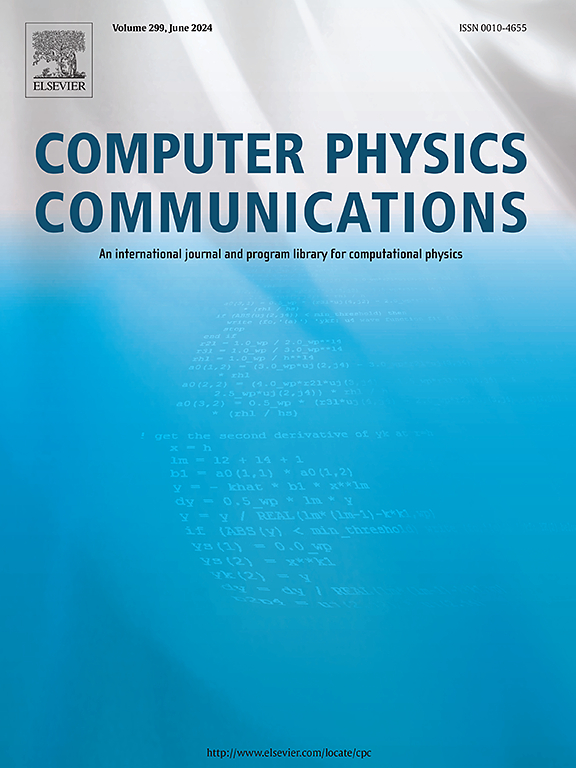OpenSBLI v3.0: High-fidelity multi-block transonic aerofoil CFD simulations using domain specific languages on GPUs
IF 7.2
2区 物理与天体物理
Q1 COMPUTER SCIENCE, INTERDISCIPLINARY APPLICATIONS
引用次数: 0
Abstract
OpenSBLI is an automatic code-generation framework for compressible Computational Fluid Dynamics (CFD) simulations on heterogeneous computing architectures (previous release: Lusher et al. (2021) [4]). OpenSBLI is coupled to the Oxford Parallel Structured (OPS) Domain Specific Language (DSL), which uses source-to-source translation to enable parallel execution of the code on large-scale supercomputers, including multi-GPU clusters. To date, OpenSBLI has largely been applied to compressible turbulence and shock-wave/boundary-layer interactions on very simple geometries comprised of single mesh blocks with essentially orthogonal grid lines. OpenSBLI has been extended in this new release to target strongly curvilinear cases, including transonic aerofoils using multi-block grids. In addition to multi-block mesh support, more efficient numerical shock-capturing methods and filters have been added to the codebase. Improvements to post-processing, reduced-dimension data output, and coupling to a modal decomposition library are also included. A set of validation cases are presented to showcase the new code features. Furthermore, state-of-the-art wide-span transonic aerofoil simulations on up to grid points demonstrate that wider aspect ratios can alter buffet predictions and increase the regularity of the low-frequency shock oscillations by accommodating fully-developed trailing edge flow separation. Spectral Proper Orthogonal Decomposition (SPOD) analysis showed that overly-narrow aerofoil simulations contain additional domain-dependent energy content at a Strouhal number of associated with wake modes.
OpenSBLI v3.0:在 GPU 上使用特定领域语言进行高保真多区块跨声速气流箔 CFD 仿真
OpenSBLI 是一个自动代码生成框架,用于在异构计算架构上进行可压缩计算流体动力学(CFD)模拟(上一版本:Lusher 等人 (2021) [4]):Lusher et al. (2021) [4])。OpenSBLI与牛津并行结构化(OPS)领域专用语言(DSL)相耦合,后者使用源对源翻译,使代码能够在大规模超级计算机(包括多GPU集群)上并行执行。迄今为止,OpenSBLI 主要应用于可压缩湍流和冲击波/边界层相互作用,其几何结构非常简单,由基本正交网格线的单一网格块组成。OpenSBLI 在新版本中进行了扩展,可用于强曲线情况,包括使用多块网格的跨音速气膜。除了支持多块网格外,代码库中还添加了更高效的数值冲击捕获方法和滤波器。此外,还改进了后处理、缩减维度数据输出以及与模态分解库的耦合。为展示新的代码功能,还提供了一组验证案例。此外,在多达 N=2.5×109 个网格点上进行的最先进的大跨度跨音速气膜模拟表明,更宽的纵横比可以改变缓冲预测,并通过容纳充分发展的后缘流分离来增加低频冲击振荡的规律性。光谱适当正交分解(SPOD)分析表明,过窄的气膜模拟在斯特劳哈尔数为 St≈3 时包含与尾流模式相关的额外域相关能量含量。
本文章由计算机程序翻译,如有差异,请以英文原文为准。
求助全文
约1分钟内获得全文
求助全文
来源期刊

Computer Physics Communications
物理-计算机:跨学科应用
CiteScore
12.10
自引率
3.20%
发文量
287
审稿时长
5.3 months
期刊介绍:
The focus of CPC is on contemporary computational methods and techniques and their implementation, the effectiveness of which will normally be evidenced by the author(s) within the context of a substantive problem in physics. Within this setting CPC publishes two types of paper.
Computer Programs in Physics (CPiP)
These papers describe significant computer programs to be archived in the CPC Program Library which is held in the Mendeley Data repository. The submitted software must be covered by an approved open source licence. Papers and associated computer programs that address a problem of contemporary interest in physics that cannot be solved by current software are particularly encouraged.
Computational Physics Papers (CP)
These are research papers in, but are not limited to, the following themes across computational physics and related disciplines.
mathematical and numerical methods and algorithms;
computational models including those associated with the design, control and analysis of experiments; and
algebraic computation.
Each will normally include software implementation and performance details. The software implementation should, ideally, be available via GitHub, Zenodo or an institutional repository.In addition, research papers on the impact of advanced computer architecture and special purpose computers on computing in the physical sciences and software topics related to, and of importance in, the physical sciences may be considered.
 求助内容:
求助内容: 应助结果提醒方式:
应助结果提醒方式:


